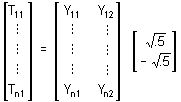Generalized Linear Model (GLM) Introductory Overview - Within-Subject (Repeated Measures) Designs Overview
It is quite common for researchers to administer the same test to the same subjects repeatedly over a period of time or under varying circumstances. In essence, one is interested in examining differences within each subject, for example, subjects' improvement over time. Such designs are referred to as within-subject designs or repeated measures designs. A basic introduction to repeated measures designs is also provided in the Between-Groups and Repeated Measures topic of the Introductory Overview of the ANOVA/MANOVA module.
For example, imagine that one wants to monitor the improvement of students' algebra skills over two months of instruction. A standardized algebra test is administered after one month (level 1 of the repeated measures factor), and a comparable test is administered after two months (level 2 of the repeated measures factor). Thus, the repeated measures factor (Time) has 2 levels.
Now, suppose that scores for the 2 algebra tests (i.e., values on the Y1 and Y2 variables at Time 1 and Time 2, respectively) are transformed into scores on a new composite variable (i.e., values on the T1), using the linear transformation
T = YM
where M is an orthonormal contrast matrix. Specifically, if
then the difference of the mean score on T1 from 0 indicates the improvement (or deterioration) of scores across the 2 levels of Time.
Between-subject designs
Within-subject (repeated measures) designs
Multivariate designs

